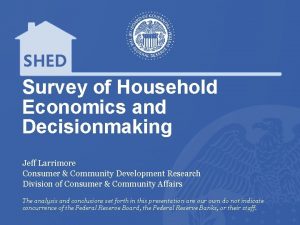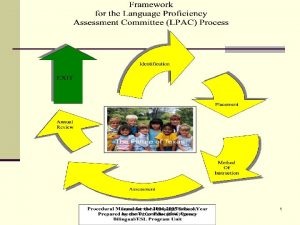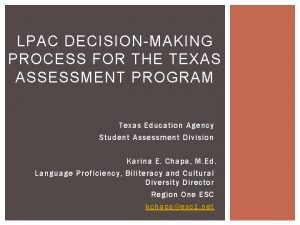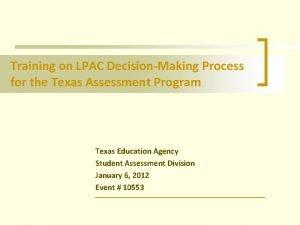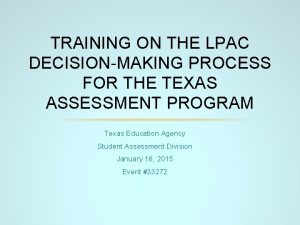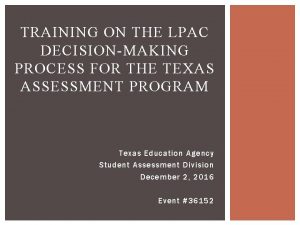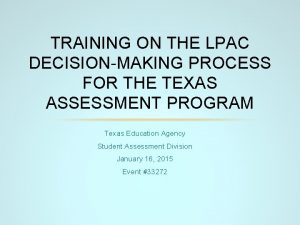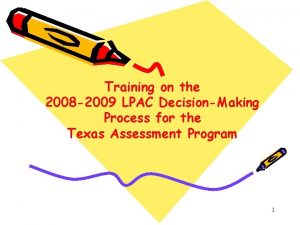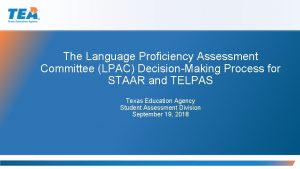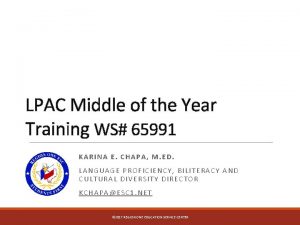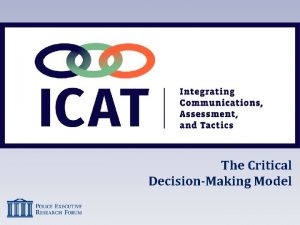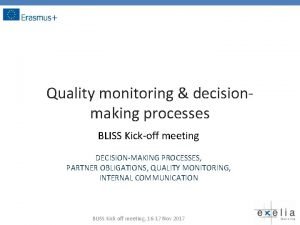Training on the LPAC DecisionMaking Process for the


















































































- Slides: 82

Training on the LPAC Decision-Making Process for the Texas Assessment Program Mc. Kinney ISD February 2016

Please Note: This training does NOT take the place of reading the appropriate decision-making guides, linguistic accommodation training and applicable manuals referenced today and provided by TEA. 2

3

Training Topics STAAR 2016 STAAR Decision-Making Guide for LPACs 2016 Linguistic Accommodations for ELLs Participating in the STAAR Program Suggested documentation forms TAKS Decision-Making Guide for LPACs Suggested documentation forms TELPAS 2016 TELPAS Decision-Making Guide for LPACs Spring data collection information 4

STAAR Decision-Making Process 5

STAAR Decision-Making Guide for LPACs The regulatory procedural guide is based on 19 TAC Chapter 101, Subchapter AA. LPACs should be familiar with these Commissioner of Education rules. TEA is required to develop administrative procedures to implement ELL assessment statutory requirements. LPACs are required to follow these administrative procedures. 6

LPAC Decision-Making Process for STAAR LPACs are responsible for — following administrative procedures in this guide making decisions on individual student basis working as a committee to make decisions maintaining required documentation The guidelines described in this training are applicable for all assessments administered in the 2016 calendar year. 7

ELPS and TEKS LPAC assessment decision-making process for STAAR supports ELPS and TEKS implementation Process helps ensure regular monitoring of ELLs’ progress and linguistic supports they receive Needs of ELLs at beginning or intermediate level of English language proficiency are emphasized in Overview section ELPS requirements specific to this group of ELLs should be emphasized in LPAC training LPAC procedures required by this guide help monitor needs of these students 8

STAAR Program and Decisions STAAR encompasses― STAAR (general state assessment) STAAR Spanish STAAR L STAAR Alternate 2 LPACs are required to make and document assessment decisions in accordance with outlined procedures. 9

STAAR Participation Decisions 10

Participation in General STAAR Assessment Taken by ELLs and other students not administered STAAR Spanish, STAAR L, STAAR A or STAAR Alternate 2 LPACs should be aware that — STAAR L is for mathematics*, science, and social studies, not reading and writing STAAR Spanish is for grades 3– 5 only ELLs taking general STAAR assessments are permitted some linguistic accommodations *STAAR L is not available for Algebra II. 11

STAAR, STAAR Spanish, STAAR L, STAAR A Same: Assessed curriculum and item types STAAR blueprints for building tests Achievement standard alignment Focus on readiness for next grade level or course with goal of postsecondary readiness Differences: Language accessibility STAAR Spanish—native language help students understand language of test. STAAR L—English language accommodations help students understand language of test. Other accessibility STAAR A—embedded supports help students with disabilities access the content being assessed. 12

ELL Participation in STAAR Spanish and STAAR L STAAR Spanish For any student for whom Spanish version of STAAR is most appropriate measure of academic progress STAAR L* ELLs for whom all of these apply may take STAAR L: • STAAR Spanish not most appropriate measure of academic progress (or does not exist at student’s grade) • Student has not yet attained advanced high TELPAS reading rating in grade 2 or above • Student is within first 3 years in U. S. (unless unschooled asylee/refugee, then first 5) *For STAAR L EOC tests, eligibility can be carried over from spring to the July and December administrations 13

STAAR Spanish Decisions When making STAAR Spanish decisions, LPAC must make individual student decisions use input from student’s teacher(s) determine STAAR Spanish to be most appropriate measure of student’s academic progress Grade-based or program-based decisions are not authorized. NOTE: For the STAAR program, whether a student has been retained and would be taking STAAR in Spanish for more than 3 years is not a limiting factor. 14

STAAR Spanish for Students in ESL Programs In addition to being appropriate for ELLs in bilingual programs who are receiving academic instruction in Spanish, STAAR Spanish may sometimes be appropriate for students in ESL programs. ESL program examples: Spanish speakers who have recently moved to the U. S. ELLs who have recently moved from a campus where they were enrolled in bilingual program Students who receive substantial academic support in Spanish 15

STAAR Spanish Considerations in STAAR L Eligibility Criteria Remember: The first STAAR L eligibility requirement is that STAAR Spanish is not the most appropriate measure of student’s academic progress. The LPAC must decide that STAAR Spanish is not the assessment that best allows the student to show his or her knowledge and skills. For Spanish speakers in grades 3– 5 otherwise eligible for STAAR L, this must specifically be discussed by the LPAC. If STAAR Spanish would be more appropriate, the student is not eligible for STAAR L. 16

Non-ELLs in Spanish Bilingual Programs Non-ELLs in a state-approved bilingual education program may be administered STAAR Spanish if the LPAC determines the assessment in Spanish to be the most appropriate measure of the student’s academic progress. This is most common in two-way dual language programs but is not necessarily limited to these programs. Chapter 101 requires the LPAC to make the decision when a request of this type is made for a non-ELL. 17

STAAR L is for students who require moderate to substantial linguistic accommodations to understand the English used on STAAR mathematics, science, and social studies assessments. for whom clarification of word meaning in English and/or reading words aloud (in addition to potentially using a bilingual dictionary and having extra time) is important to their ability to understand challenging material written in English. 18

STAAR L If a bilingual dictionary and/or extra time will suffice, the student should take general STAAR, not STAAR L as STAAR allows these linguistic accommodations. 19

STAAR L EOC Eligibility For EOC, eligibility for STAAR L can be carried over from spring to the July and December administrations. Example: A student was in his 3 rd year in U. S. schools in the 2014– 2015 school year. He took STAAR L in May, but did not pass. The LPAC carried over eligibility to both the July 2015 and December 2015 STAAR L EOC administrations. In spring 2016, however, he will be in his 4 th year in U. S. schools and no longer eligible for STAAR L. 20

Individual Student Decisions and Final Decision-Making Close to Assessment Time Previous slides illustrate some examples of the need for — individual student decisions, and the reviewing of student progress shortly before the assessment (in cases where an assessment decision may change because of progress made). 21

Different Assessment Decisions for Different Subjects Decisions will often vary by necessity because of the design of the STAAR program. Example: Many ELLs will take STAAR for reading and writing, but STAAR L for mathematics, science, social studies. It may sometimes be appropriate to give STAAR Spanish in some subjects and STAAR or STAAR L in other subjects. LPAC decisions to give a student one type of assessment for one subject and another type of assessment for another subject should be well-justified in the required documentation. 22

Assessment Decisions for ELLs Receiving Special Education Services ELLs receiving special education services may be administered any assessment depending on whether they meet the participation requirements. STAAR STAAR Spanish L A Alternate 2 Chapter 101 of the TAC requires the LPAC to work in conjunction with the ARD committee to make assessment decisions for these students. This collaboration helps ensure that factors related to disabling conditions and second language acquisition are both carefully considered. 23

STAAR A ELLs with a disability may be administered STAAR A if they meet the specific eligibility requirements for this assessment program. The form for determining whether students meet the eligibility requirements is on the TEA STAAR A webpage. Note: STAAR A is not available for English III or Algebra II. 24

STAAR Alternate 2 ELLs receiving special education services may be administered STAAR Alternate 2 if they meet the specific participation requirements for this assessment program. (attach to linguistic accommodation page) The ARD committee form for determining whether students meet the participation requirements is on the TEA STAAR Alternate 2 webpage. 25

STAAR A and STAAR Alternate 2 Important: ELLs participate in these assessments only on the basis of their disability, not second language acquisition. The LPAC’s involvement in assessment decision-making for ELLs served by special education should help ensure that ELL participation in these assessments is appropriate. 26

Linguistic Accommodation Decisions 27

Linguistic Accommodation Resources Linguistic accommodation decisions for STAAR are to be made by LPACs in accordance with policies and procedures in two guides: 2016 STAAR Decision-Making Guide for LPACs 2016 Linguistic Accommodations for ELLs Participating in the STAAR Program Linguistic accommodation guide above is principal source of linguistic accommodation information 28

Linguistic Accommodations in Instruction Required by ELPS Support learning of both subject matter and English Made by all teachers of ELLs Monitored and adjusted by teachers as students learn more English 29

Linguistic Accommodations During State Assessment Not all accommodations suitable for instruction are allowable during state assessments. Accommodations in instruction are designed to foster and support learning. Accommodations during assessment allow test to more accurately measure degree students have met curriculum and performance standards. Standardization and test administration logistics narrow accommodation possibilities during state assessments. 30

STAAR Linguistic Accommodation Eligibility Criteria and Decisions Refer to linguistic accommodation guide. LPAC’s linguistic accommodation decisions must be made on individual student basis. Decisions must be based on — student’s particular needs for second language acquisition support, and whether student is routinely provided the accommodation in instruction and testing. Providing unfamiliar accommodations may hinder rather than help a student. LPACs must coordinate with subject area teachers. 31

Accommodations for ELLs with Disabilities For these students, LPACs are responsible for making accommodation decisions for the STAAR program in conjunction with the student’s ARD or Section 504 committee, as applicable. Linguistic accommodation decisions Accommodation decisions related to the student’s disability These committees should become familiar with all accommodation information on the TEA Accommodation Resources webpage. 32

LPAC Role In coordinating with subject area teachers on linguistic accommodations for STAAR, the LPAC’s role should not be simply to make decisions and process paperwork. The LPAC process provides opportunities for guiding teachers, supporting ELPS implementation, and determining needs for professional development. 33

Coordinating Between LPAC and Testing Coordinators Testing coordinators and LPACs must coordinate so that participation and accommodation decisions are available in time to make testing arrangements. Remember, linguistic accommodations are not just for STAAR L. 34

Differing Degrees of Linguistic Accommodation STAAR (General) STAAR L STAAR Alternate 2 Limited degree of linguistic accommodation Moderate to substantial degree of linguistic accommodation Degree varies in accordance with second language acquisition needs of ELLs who qualify for this test No specific linguistic accommodations; assessment design allows other languages and communication methods to be used as appropriate STAAR Spanish: Assessment is provided in student’s native language; other linguistic accommodations not applicable. 35

Linguistic Accommodations for STAAR Mathematics, Science, Social Studies Reading, Writing, English II, English III • Bilingual dictionary • Dictionaries of various types* • Extra time (same day) • Clarification in English of meaning of • words in writing prompt for all writing assessments • words in short-answer reading questions in English I-III *Dictionary policy provided for all students in grades 6 and up includes use of standard English, ESL, sign language, and bilingual dictionaries. 36

Linguistic Accommodations for STAAR L Mathematics*, Science, Social Studies • Clarification in English of word meaning** • Reading aloud of text** • Bilingual dictionary • Extra time (same day) *STAAR L not available for Algebra II **Provided in online interface 37

Linguistic Accommodations for STAAR A Math*, Science, Social Studies Reading, Writing, English II* • Bilingual dictionary • Dictionaries of various types** • Extra time (same day) • Clarification in English of word meaning *STAAR A not available for English III and Algebra II. **Dictionary policy provided for all students in grades 6 and up includes use of standard English, ESL, sign language, and bilingual dictionaries. 38

Extra Time (Same Day) as a Linguistic Accommodation Permitted for any ELL who meets eligibility criteria LPACs must adhere to eligibility criteria for this accommodation (page 6 of linguistic accommodation guide). Not an “automatic” decision Extra time not permitted beyond regularly scheduled school day. As a linguistic accommodation, this applies only to STAAR assessments administered in English. 39

Extra Time (Same Day) Specific Eligibility Criteria Routine use in specified contexts: ELL must need and routinely be provided extra time when completing assignments and assessments that require substantial comprehension or use a substantial amount of English. Is the student given extra time in class to complete assignments? Second language acquisition needs: Needs must relate to second language acquisition factors, that is, the time the ELL needs to read meaningfully in English (or write a response, as applicable to subject assessed) as a function of learning the English language. Nonfactors: Factors that are not ELL-specific must not be considered, such as test anxiety, use of test strategies, or other reasons not related to second language acquisition. 40

Dictionaries LPACs should be very familiar with information about allowable types of dictionaries in linguistic accommodation guide LPACs should also be very familiar with STAAR/STAAR A dictionary policy for all students, which is available on TEA’s STAAR Reading Resources webpage at http: //tea. texas. gov/student. assessment/staar/reading/ May need to discuss Equality vs Equity if you have classes sprinkled with students that will have access to resources that others will not have access to. 41

42

Decisions about Special Provision and Exemption 43

English I EOC Special Provision TAC § 101. 1007 For ELLs who ― have been enrolled in U. S. schools 3 school years or less (5 or less if qualifying unschooled asylee/refugee), and have not yet attained TELPAS advanced high reading rating in grade 2 or above. Why this provision? In English I/ESOL I, these students may require substantial instructional scaffolding and linguistic adaptation not feasible on standardized language arts assessments. 44

English I Special Provision When enrolled in an English I/ESOL I course, an eligible ELL shall not be required to retake the assessment each time it is administered if the student passes the course but does not pass the test. Note: • Students are not exempt from testing while in the course. • Students (newcomers that arrive in Spring) still need to have an English 1 Special Provision form completed during the Spring administration. • Provisions do not apply to English II. • This provision is not tied to any particular graduation plan. 45

EOCs & Newcomers that arrive in the spring Have never taken the 1 st semester portion of a course Should not take an EOC until they have completed both portions of a course. 46

Exemption for Qualifying Asylees and Refugees Amendment to 19 TAC § 101. 1005 allows for the exemption of certain qualifying ELL asylees and refugees from being administered a STAAR assessment in grades 3– 8. This exemption only applies to those unschooled asylees and refugees in their first year in U. S. schools. 47

STAAR L 48

STAAR L Online Tests STAAR L is administered as an online testing program in grades 3– 8 and EOC. Clarification in English and reading aloud is provided in online interface. Students will need headphones if testing in a group. 49

STAAR L Student Tutorial. REQUIRED New tutorial familiarizes students with online interface No content Test administration directions for STAAR L assessments will assume familiarity with online interface No longer sample items at beginning of each STAAR L test Should be available in the next 7 days Tutorial will come out before the practice sets 50

STAAR L Tools Practice New Replacing STAAR L Practice Sets Limited practice (only 2 -3 items per grade/subject) Allows students to practice using STAAR L online accommodations and tools as they will be presented in new online testing interface 51

STAAR L Online Accommodations and LPAC Decision-Making All students taking STAAR L will have access to the accommodations of clarification in English and reading aloud of text. As part of the decision-making process, LPACs should determine and document whether the student needs at least one of these accommodations. If not, the student should take STAAR. 52

STAAR L and SSI For the 2015– 2016 school year, the Student Success Initiative (SSI) will be reinstituted. Retest opportunities will be offered for grades 5 and 8 reading and mathematics on dates shown on the 2015– 2016 testing calendar. 53

STAAR L Paper Administrations Paper test booklets will be approved by TEA in rare circumstances. Accommodations that are not available in new STAAR online testing interface Unavoidable technological problems that make online testing impossible Other special situations (e. g. , homebound students, JJAEPs, etc. ) Detailed information about special paper request process will be posted on Coordinator Manual Resources page at http: //tea. texas. gov/student. assessment/manuals/dccm/. 54

ELLs with Parental Denials 55

ELLs with Parental Denials TAC § 101. 1005 (f) An ELL whose parent or guardian has declined bilingual/ESL services required by state law is not eligible for special ELL assessment, accommodation, or accountability provisions. No testing in Spanish No linguistic accommodations during testing No English I special provision No unschooled asylee/refugee provisions No STAAR-L 56

Documentation of STAAR Test Decisions 57

Documentation Requirements Who LPAC What Decisions • • Test Participation Accommodations* English I Special Provision Exemption (asylee/refugee) ARD Committee • Test Participation • Accommodations* Section 504 Placement Committee • Test Participation • Accommodations* Where Documented • Student’s Permanent Record File • Student’s IEP • Student’s IAP *Linguistic accommodations and accommodations related to applicable disability 58

Suggested Forms for LPAC Use STAAR Participation and Linguistic Accommodation Decisions Eligibility for STAAR English I Assessment Special Provision Student History Worksheet Forms may be modified and reformatted for local use (Microsoft Word format). School districts may require additional supporting documentation and evidence. Available at http: //tea. texas. gov/student. assessment/ell/lpac/ 59

STAAR Participation and Linguistic Accommodation Decisions Part I of form addresses justification for test participation decision. TAC § 101. 1005 requires decision and justification to be documented. Part II of form lists test participation and linguistic accommodation decisions. Part II could be copied and provided to testing coordinators. 60

Eligibility for STAAR English I Assessment Special Provision Form includes TAC special provision and eligibility criteria Course participation (semester or school year) and assessment date must be documented for each ELL that meets eligibility criteria. Documentation must be completed and discussed with student as close to the time of the assessment as possible. Special provision only applies when student meets Theeligibility student maycriteria opt to retake thepassessment during any scheduled and the course. administration if the student passes the course but fails to meet the passing standard. 61

Student History Worksheet Multiple-year student record of — number of school years of enrollment in U. S. TELPAS reading rating test decisions whether student enrolled 60 consecutive school days in a school year Includes signature and date area for each year’s updated Years in U. S. Schools information to help ensure annual accuracy of this important data collection 62

One last word about providing linguistic accommodations…. . If a student has scored Advanced High on TELPAS Reading, that is a data indicator that the student may not need linguistic accommodations on STAAR Reading. If a student has scored Advanced High on TELPAS Writing, that is a data indicator that the student may not need linguistic accommodations on STAAR Writing. Look at student data when making assessment decisions. 63

TAKS Decision-Making Process 64

TAKS Decision-Making Process No changes to process Applicable only to students for whom TAKS is a graduation requirement Includes Exit level LEP postponement TAKS provisions for ELLs receiving special education services TAKS provisions for unschooled asylees and refugees TAKS Decision-Making Guide for LPACs and sample documentation forms available on Language Proficiency Assessment Committee Resources page at 65

TELPAS 66

TELPAS Resources for LPACs Years in U. S. Schools Data Collection Document Years in U. S. schools collected annually for each ELL during TELPAS Used in determining performance requirements in varied state and federal accountability measures Document contains instructions for determining years in U. S. schools, including 60 -day rule information 2016 TELPAS Decision-Making Guide for LPACs Includes information on assessing ELLs receiving special education services with TELPAS Online Tutorial is now available! 67

TELPAS Online Reading Test Student Tutorials – REQUIRED!!! http: //www. pearsononlinetesting. com/tx/TELPAS/tut orials/ To download the installable Test. Nav app go to: https: //support. assessment. pearson. com/display/T N/Installable+Test. Nav+Setup+Overview To access the browser-based Test. Nav 8 login screen, go to: http: //tx 8. testnav. com/client/index. html 68

Data Collection for Spring In addition to years in U. S. schools, other information that will be collected includes Unschooled asylees/refugees These students lack literacy skills in their first language and basic subject-matter knowledge and skills. They may also lack basic social skills and have experienced emotional trauma as a result of their previous circumstances. Students with Interrupted Formal Education (SIFE) These ELLs attend school in the U. S. , withdraw and leave the U. S. for a period of time, and then return to the U. S. The period of time outside of the U. S. or the number of times the student is withdrawn from U. S. schools is significant enough that growth in English and learning of subject matter are affected. These ELLs may come to the U. S. with limited or no prior schooling. They lack literacy skills in their first language, basic subject-matter knowledge and skills, or basic social skills. For the purpose of this data collection, include ELLs who did not attend school for a period of time such that the ability to learn English and new grade level subject-matter knowledge and skills is significantly affected. 69

TELPAS Collaboration Required Secondary – Campus ESL teacher would be an excellent collaborator Listening and Speaking domains – how are they evaluated? Is there enough interaction in class to rate? Are they FES on IPT? PLDs should be used year-round to assess student progress and to move the student to the next proficiency level 70

Calculating Years in US Schools Example 1 A student arrives from out of the country and enrolls for the first time in a U. S. school in Campus A in early March 2015. The student remains enrolled for 37 school days and then withdraws. The student is not enrolled in any school for 7 days. The same student then enrolls in Campus B and remains enrolled through the remainder of the school year. The student was enrolled for a total of more than 60 school days in the 2014– 2015 school year and was not un-enrolled for a time period of 10 or more school days. Therefore, the LPAC at Campus B must count the 2014– 2015 school year as year one in U. S. schools for that student. The following 2015– 2016 school year, the student is considered to be in year two. 71

Calculating Years in US Schools Example 2 A student arrives from out of the country and enrolls for the first time in a U. S. school in Campus A in early April 2015. The student remains enrolled for the rest of the school year. Because the student was enrolled for only 49 consecutive school days, the LPAC at Campus A cannot count the 2014– 2015 school year as year one in U. S. schools. The following 2015– 2016 school year, the student is still considered to be in his or her first year in U. S. schools. 72

Important Reminders Districts are not changing the value for years in U. S. schools submitted in a previous school year. Districts are using the data previously submitted to inform data that will be submitted this spring. The number of years in U. S. schools on record for a student will never decrease. The value will either remain the same or increase by 1. 73

74

75

76

Who can be a rater? 77

For More Information This Power. Point and all other LPAC guides and documents is posted on the Language Proficiency Assessment Committee Resources page of the Student Assessment Division website at http: //tea. texas. gov/student. assessment/ell/lpac/ For more information — go to http: //tea. texas. gov/student. assessment/ell/ or consult with a coordinator from your district or education service center If additional assistance is needed, contact the TEA Student Assessment Division (512) 463 -9536 ell. tests@tea. texas. gov 78

Needed LPAC Documents STAAR Participation & Linguistic Accommodation Decisions STAAR/TELPAS Assessment Decisions Minutes English 1 Special Provisions Form (high school only) Unschooled Asylee & Refugee Form (grades 3 -8 only) Student History Form 79

STAAR Participation and Linguistic Accommodation Decisions 80

The Back Side of STAAR Participation & Ling Acc Decisions page 81

LPAC Minutes 82
 Survey of household economics and decisionmaking
Survey of household economics and decisionmaking Lpac assessment
Lpac assessment Lpac student history worksheet
Lpac student history worksheet Language proficiency
Language proficiency Iso 22301 utbildning
Iso 22301 utbildning Typiska drag för en novell
Typiska drag för en novell Tack för att ni lyssnade bild
Tack för att ni lyssnade bild Vad står k.r.å.k.a.n för
Vad står k.r.å.k.a.n för Shingelfrisyren
Shingelfrisyren En lathund för arbete med kontinuitetshantering
En lathund för arbete med kontinuitetshantering Underlag för särskild löneskatt på pensionskostnader
Underlag för särskild löneskatt på pensionskostnader Tidböcker
Tidböcker Sura för anatom
Sura för anatom Förklara densitet för barn
Förklara densitet för barn Datorkunskap för nybörjare
Datorkunskap för nybörjare Tack för att ni lyssnade bild
Tack för att ni lyssnade bild Att skriva debattartikel
Att skriva debattartikel Delegerande ledarstil
Delegerande ledarstil Nyckelkompetenser för livslångt lärande
Nyckelkompetenser för livslångt lärande Påbyggnader för flakfordon
Påbyggnader för flakfordon Lufttryck formel
Lufttryck formel Svenskt ramverk för digital samverkan
Svenskt ramverk för digital samverkan Kyssande vind analys
Kyssande vind analys Presentera för publik crossboss
Presentera för publik crossboss Argument för teckenspråk som minoritetsspråk
Argument för teckenspråk som minoritetsspråk Bat mitza
Bat mitza Klassificeringsstruktur för kommunala verksamheter
Klassificeringsstruktur för kommunala verksamheter Mjälthilus
Mjälthilus Claes martinsson
Claes martinsson Cks
Cks Lågenergihus nyproduktion
Lågenergihus nyproduktion Bra mat för unga idrottare
Bra mat för unga idrottare Verktyg för automatisering av utbetalningar
Verktyg för automatisering av utbetalningar Rutin för avvikelsehantering
Rutin för avvikelsehantering Smärtskolan kunskap för livet
Smärtskolan kunskap för livet Ministerstyre för och nackdelar
Ministerstyre för och nackdelar Tack för att ni har lyssnat
Tack för att ni har lyssnat Vad är referatmarkeringar
Vad är referatmarkeringar Redogör för vad psykologi är
Redogör för vad psykologi är Matematisk modellering eksempel
Matematisk modellering eksempel Tack för att ni har lyssnat
Tack för att ni har lyssnat Borra hål för knoppar
Borra hål för knoppar Vilken grundregel finns det för tronföljden i sverige?
Vilken grundregel finns det för tronföljden i sverige? Formula varians
Formula varians Tack för att ni har lyssnat
Tack för att ni har lyssnat Steg för steg rita
Steg för steg rita Verksamhetsanalys exempel
Verksamhetsanalys exempel Tobinskatten för och nackdelar
Tobinskatten för och nackdelar Toppslätskivling effekt
Toppslätskivling effekt Datumr
Datumr Egg för emanuel
Egg för emanuel Elektronik för barn
Elektronik för barn Fredsgudinna
Fredsgudinna Strategi för svensk viltförvaltning
Strategi för svensk viltförvaltning Kung som dog 1611
Kung som dog 1611 Humanitr
Humanitr Ro i rom pax
Ro i rom pax Tack för att ni lyssnade
Tack för att ni lyssnade Större och mindre tecken
Större och mindre tecken Vad är prosa
Vad är prosa Inköpsprocessen steg för steg
Inköpsprocessen steg för steg Rådet för byggkompetens
Rådet för byggkompetens Ledarskapsteorier
Ledarskapsteorier Skivepiteldysplasi
Skivepiteldysplasi Myndigheten för delaktighet
Myndigheten för delaktighet Frgar
Frgar Tillitsbaserad ledning
Tillitsbaserad ledning Läkarutlåtande för livränta
Läkarutlåtande för livränta Frger
Frger Lek med geometriska former
Lek med geometriska former Shivaismen
Shivaismen Meios steg för steg
Meios steg för steg Bris för vuxna
Bris för vuxna Bamse för de yngsta
Bamse för de yngsta Hình ảnh bộ gõ cơ thể búng tay
Hình ảnh bộ gõ cơ thể búng tay Frameset trong html5
Frameset trong html5 Bổ thể
Bổ thể Tỉ lệ cơ thể trẻ em
Tỉ lệ cơ thể trẻ em Voi kéo gỗ như thế nào
Voi kéo gỗ như thế nào Chụp tư thế worms-breton
Chụp tư thế worms-breton Chúa yêu trần thế alleluia
Chúa yêu trần thế alleluia Các môn thể thao bắt đầu bằng tiếng đua
Các môn thể thao bắt đầu bằng tiếng đua Thế nào là hệ số cao nhất
Thế nào là hệ số cao nhất
